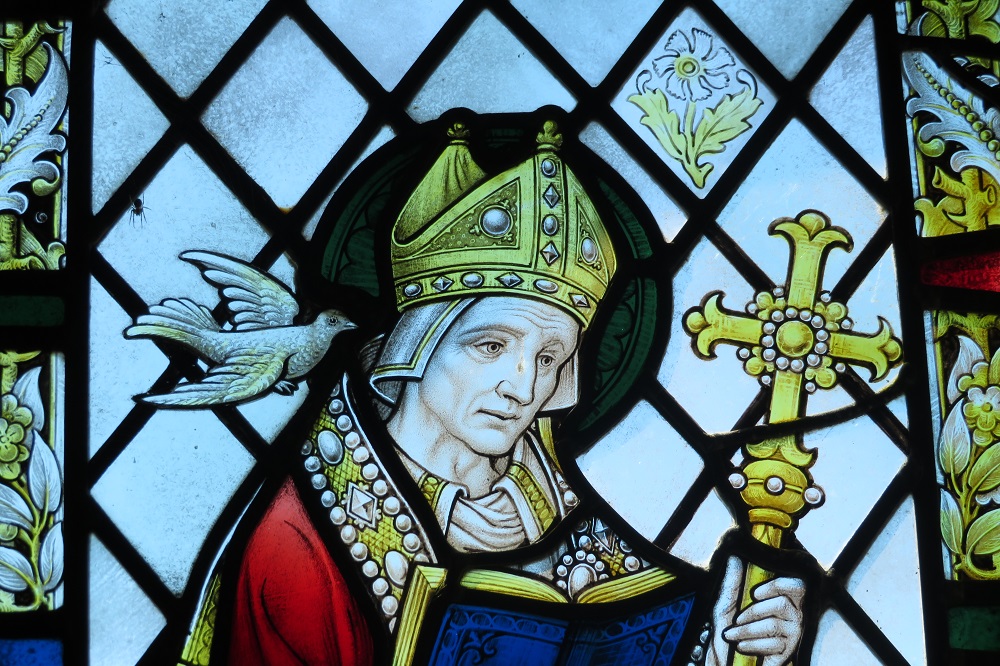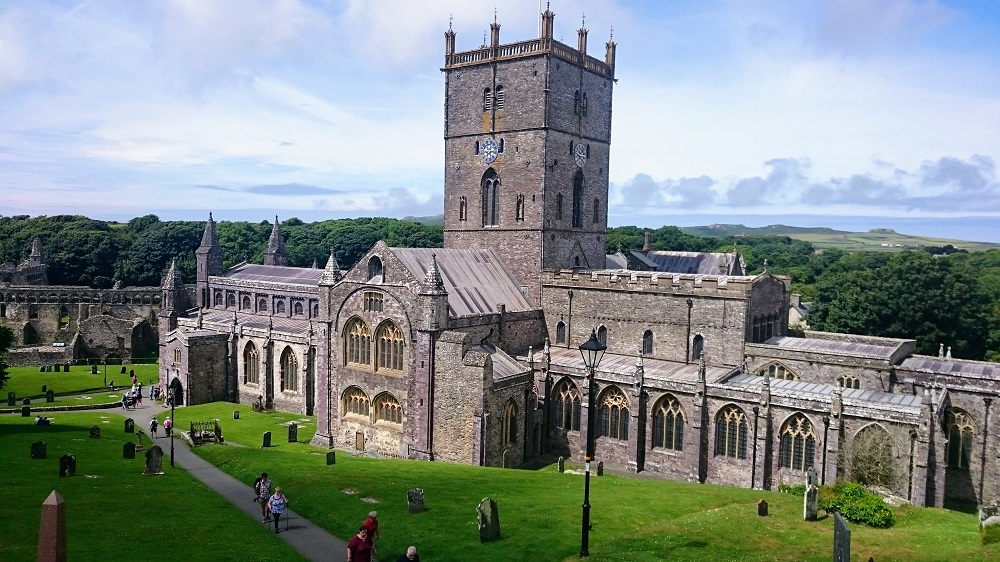St David’s Day: how a sixth century monk inspired centuries of devoted followers and poets

Helen Fulton, Professor and Chair of Medieval Literature, University of Bristol, Jonathan M. Wooding
Honorary Professor, University of Sydney
The man we know as St David, or Dewi Sant in Welsh, lived in the sixth century in the west of the island of Britain. He founded a monastic community on the site of what is now St Davids Cathedral in Pembrokeshire.
David was celebrated in both Wales and Ireland, but what we know about him and his followers mostly comes from the Latin text, Vita S. David (Life of St David), which was written by the author Rhygyfarch in around 1080.
Rhygyfarch was a member of a clerical community at Llanbadarn Fawr, which is in modern day Ceredigion, west Wales. His writing is evidence of the lasting cult associated with Saint David and the many medieval churches dedicated to him throughout Wales. By “cult”, we mean the continued devotion to David’s life and work.
Rhygyfarch’s writing in some ways presents us with two different Davids. The first is the archbishop who would become the patron of a major local church as well as a nation. The other is the abbot of a hermit-like community, who required his monks to live on little more than bread and water.
Cheerless
But, according to Rhygyfarch, they were not allowed too much even of those, as “being filled to excess, even with bread on its own, gives rise to dissipation [self-indulgence]”. The ideal setting for this somewhat cheerless regimen was a remote place, away from the temptations of secular life.
Experts have reason to believe that Rhygyfarch’s account of David is authentic because the monastic programme he described corresponds closely to the rule of an anonymous abbot who was witheringly criticised by the sixth century churchman and author, Gildas. Gildas was the author of the earliest surviving history of Britain, De Excidio Britanniae (On the Ruin of Britain), in which he blamed the Britons for their defeat by the Saxons.
David’s austerity, which saw him nicknamed aquaticus (waterman) by Rhygyfarch and others, appears to be authentic. And it goes some way to explaining why we find his great cathedral in a marshy valley at the extreme edge of south-west Wales.
Rhygyfarch’s writing inspired a number of later texts, including the Welsh language Buchedd Dewi, which was written in the 14th century. In it, it says that David’s last words were “gwnewch y pethau bychain”, which means “do the little things”.
Welsh court poets before the English conquest of Wales in 1282 would invoke David as a saint who represented the national interest of Wales, while later poets insisted on his superiority to other saints.
Most strikingly, the saint was drawn into the rich tradition of poetic prophecy. This asserted that the Welsh people would one day win their country back from the English.
It was a tradition recorded from the tenth century onward and which persisted until the Reformation in the 16th century, when the Church of England broke away from the Catholic Church.

The cathedral at St Davids is an example of the extent of the medieval devotion to David. It is no simple architectural effort. Its construction started in 1182 and it is a richly-decorated masterpiece. The surrounding terrain was challenging, so presumably the location was non-negotiable. The building fell down twice, firstly in 1220 and then in 1248, before stability was eventually achieved.
Bishops in 1538 and 1666, who were unsympathetic to pilgrimage and mindful of spiritual concerns, attempted to move the bishop’s throne 45 miles east to the town of Carmarthen. That they failed is testimony to the seismic force of the cult of St David.
This year marks the ninth centenary of a papal bull (a decree) issued by Pope Calixtus II confirming the estates and buildings of the bishops of Menevia (the Latin name of the diocese of St Davids, known as Mynyw in Welsh).
Contrary to popular belief, Calixtus did not canonise St David, because it was not required of an early saint. The English historian, William of Malmesbury, writing in the 1120s, said Calixtus encouraged pilgrims to go to Menevia, because “those who went twice to St Davids should have the same privileges in the way of benediction as those as those who went once to Rome”.
Pilgrimages
Later Welsh poets picked up on the same formulation to promote the importance of the cathedral. In the late 14th century, the poet Iolo Goch reiterated that two pilgrimages to St Davids were equivalent to one pilgrimage to Rome, and added that three to St Davids equalled one to Jerusalem.
The bard Ieuan ap Rhydderch, writing in the first half of the 15th century, repeated this in his long poem dedicated to David and declared “Nid gwell sant, ffyniant ei ffawd / Na Dewi (“There is no better saint than Dewi, good fortune his blessing”).
David died in around AD600. A reference to his banner leading the Welsh forces in the tenth-century prophetic poem, Armes Prydein, suggests that by that point he was thought of as the patron saint of the Welsh people.
The feast of St David on March 1 was a religious festival up until the Reformation. It then survived as a national day of commemoration throughout the following centuries.
The cult of Dewi Sant lives on to the present day as a potent symbol of Welsh national identity.
This article was first published on The Conversation.
![]()
Support our Nation today
For the price of a cup of coffee a month you can help us create an independent, not-for-profit, national news service for the people of Wales, by the people of Wales.







The sad fact about Dewi is the final outrage played on his remains, particularly when you understand how important such remains were to the religious feelings of the time.
“Do the little things” is a deep wisdom. There are many cases in history where people with great experience and intellect said to others similar sentences. The book by that wiley old boy Lao-Tzu, Te Tao Ching, mentioned many times in the text that great deeds and problems start of as the smallest of things. Tsunetomo recounts “Among the maxims on Lord Naoshige’s wall there was this one: ”Matters of great concern should be treated lightly.” Master lttei commented, “Matters of small concern should be treated seriously.” ” …and of course “Do the little things” can also mean one should… Read more »
Agreed – and also, doing the little things is sometimes the only thing possible. Just getting out of bed, brushing your teeth, and getting through the day.